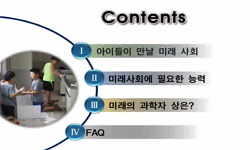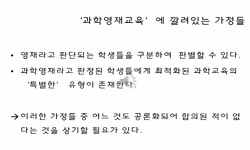This study aims to analyse the relationship between multiple intelligence and scientific creativity of science- gifted elementary students focusing on the subject of biology. For this, 37 science-gifted fifth-graders in the Science-Gifted Education Ce...
http://chineseinput.net/에서 pinyin(병음)방식으로 중국어를 변환할 수 있습니다.
변환된 중국어를 복사하여 사용하시면 됩니다.
- 中文 을 입력하시려면 zhongwen을 입력하시고 space를누르시면됩니다.
- 北京 을 입력하시려면 beijing을 입력하시고 space를 누르시면 됩니다.

초등과학영재학생의 과학창의성과 다중지능의 관계 - 생명 영역을 중심으로 - = The Relationship between Scientific Creativity of Science-gifted Elementary Students and Multiple Intelligence- Focusing on the Subject of Biology -
한글로보기https://www.riss.kr/link?id=A107015959
- 저자
- 발행기관
- 학술지명
- 권호사항
-
발행연도
2020
-
작성언어
Korean
- 주제어
-
등재정보
KCI등재
-
자료형태
학술저널
- 발행기관 URL
-
수록면
369-381(13쪽)
-
KCI 피인용횟수
1
- DOI식별코드
- 제공처
-
0
상세조회 -
0
다운로드
부가정보
다국어 초록 (Multilingual Abstract)
This study aims to analyse the relationship between multiple intelligence and scientific creativity of science- gifted elementary students focusing on the subject of biology. For this, 37 science-gifted fifth-graders in the Science-Gifted Education Center at an Office of Education conducted a multiple intelligence test. In addition, researchers collected science-gifted students’ results of scientific creativity activity at the botanical garden field trip. The main findings from this study are as follows: First, strong intelligence was logical-mathematical intelligence for gifted students, and weak intelligence was found to be naturalistic intelligence for them. Second, there was no significant correlation in the relationship between multiple intelligence and scientific creativity of science-gifted students. Third, as a result of independent two sample t-test for each intelligence and scientific creativity scores divided into the upper and lower groups, only verbal-linguistic intelligence statistically differed significantly at the level of p<.05 (t=2.13, df=35, p=0.04). Fourth, as a result of conducting a two-way analysis to see if there were any interaction effects, verbal-linguistic and visual-spatial, logical-mathematical and visual- spatial, logical-mathematical and bodily-kinesthetic, and visual-spatial and musical-rhythmic intelligence all showed significant values at the level of p<.05 level in interaction effects on originality element comprising scientific creativity. Fifth, an analysis of students with high naturalistic intelligence showed that their scores of scientific creativity tasks conducted at the botanical garden field trip were all lower. Based on the results of this study, this study discussed the implications of scientific creativity learning linking multiple intelligence in primary science education and gifted education.
참고문헌 (Reference)
1 이유림, "한국어 학습자의 어휘 습득과 어휘 표현력에 영향을 미치는 변인 연구" 한국어의미학회 49 : 163-187, 2015
2 이수현, "초등학교 영재 아동의 다중지능과 과흥분성의 관계 연구" 고려대학교 교육대학원 2009
3 진주현, "초등수학영재의 다중지능과 수학적 능력구성 요소와의 관계" 서울교육대학교 대학원 2015
4 김민주, "초등과학영재학생의 발표에 대한 인식 및 발표의 자발성과 과학창의성의 관계 분석" 한국초등과학교육학회 38 (38): 331-344, 2019
5 백성혜, "초등과학 영재학급 학생들과 일반 학생의 인지적 특성 비교 분석" 한국과학교육학회 26 (26): 307-316, 2006
6 류성림, "초등 수학영재와 학부모의 다중지능에 관한 비교 분석" 한국수학교육학회 24 (24): 807-830, 2010
7 여상인, "초․중등 수학․과학․정보 영재의 다중지능 비교" 4 (4): 1-8, 2010
8 박병기, "창의성과 지능의 관계구조" 14 (14): 235-261, 2000
9 문용린, "지능과 교육" 학지사 2003
10 홍성윤, "중다지능이론과 교수-학습 방법" (13) : 167-188, 1998
1 이유림, "한국어 학습자의 어휘 습득과 어휘 표현력에 영향을 미치는 변인 연구" 한국어의미학회 49 : 163-187, 2015
2 이수현, "초등학교 영재 아동의 다중지능과 과흥분성의 관계 연구" 고려대학교 교육대학원 2009
3 진주현, "초등수학영재의 다중지능과 수학적 능력구성 요소와의 관계" 서울교육대학교 대학원 2015
4 김민주, "초등과학영재학생의 발표에 대한 인식 및 발표의 자발성과 과학창의성의 관계 분석" 한국초등과학교육학회 38 (38): 331-344, 2019
5 백성혜, "초등과학 영재학급 학생들과 일반 학생의 인지적 특성 비교 분석" 한국과학교육학회 26 (26): 307-316, 2006
6 류성림, "초등 수학영재와 학부모의 다중지능에 관한 비교 분석" 한국수학교육학회 24 (24): 807-830, 2010
7 여상인, "초․중등 수학․과학․정보 영재의 다중지능 비교" 4 (4): 1-8, 2010
8 박병기, "창의성과 지능의 관계구조" 14 (14): 235-261, 2000
9 문용린, "지능과 교육" 학지사 2003
10 홍성윤, "중다지능이론과 교수-학습 방법" (13) : 167-188, 1998
11 최인수, "유아용 창의성 측정도구에 관한 고찰" 20 (20): 139-166, 2000
12 노명완, "유아언어교육론" 동문사 1995
13 신숙희, "어머니의 언어형태와 유아의 언어·사고능력 및 창의성과의 관계" 梨花女子大學校 敎育大學院 1987
14 백종남, "발달장애학생용 다중지능 측정도구 개발을 위한 기초연구: 국내 다중지능 측정도구 개발 연구 동향 분석" 한국지체.중복.건강장애교육학회 53 (53): 307-334, 2010
15 문용린, "다중지능이론에 기초한 진로교육 가능성 탐색" 한국진로교육학회 17 (17): 1-19, 2004
16 임채성, "과학창의성 평가 공식의 개발과 적용" 한국초등과학교육학회 33 (33): 242-257, 2014
17 박종원, "과학적 창의성 모델의 제안-인지적 측면을 중심으로-" 한국과학교육학회 24 (24): 375-386, 2004
18 윤경미, "과학영재, 인문사회영재, 일반 중학생의 다중지능 특성 비교" 한국청소년학회 15 (15): 287-313, 2008
19 성진숙, "과학에서의 창의적 문제해결력에 영향을 미치는 제 변수 분석: 확산적 사고, 과학 지식, 내.외적 동기, 성격 특성 및 가정 환경" 한국열린교육학회 11 (11): 219-237, 2003
20 송성수, "과학사의 사례를 활용한 과학자의 창의성에 관한 탐색적 연구: 다윈, 에디슨, 아인슈타인을 중심으로" 과학교육연구소 52 (52): 227-236, 2013
21 박미진, "과학․수학 영재의 다중지능, 자기조절학습능력 및 개인성향의 차이" 한국영재학회 23 (23): 697-713, 2013
22 Mumford, M. D., "Where have we been, where are we going? Taking stock in creativity research" 15 (15): 107-120, 2003
23 Jauk, E., "The relationship between intelligence and creativity : New support for the threshold hypothesis by means of empirical breakpoint detection" 41 (41): 212-221, 2013
24 Korfiatis, K. J., "The living world in the curriculum : Ecology, an essential part of biology learning" 46 (46): 125-127, 2012
25 Hargreaves, D. J., "Sex roles in divergent thinking" 47 (47): 25-32, 1977
26 Preckel, F., "Relationship of intelligence and creativity in gifted and non-gifted students : An investigation of threshold theory" 40 (40): 159-170, 2006
27 Gardner, H. E., "Multiple intelligences: New horizons in theory and practice" Basic Books 2008
28 Han, K. S., "Multiple creativities? Investigating domain-specificity of creativity in young children" 46 (46): 98-109, 2002
29 Olsen, K. D., "How education can lead the way to an integral society : A proven model for doing so already exists" 60 (60): 287-293, 2004
30 Baer, J., "How divergent thinking tests mislead us:Are the Torrance Tests still relevant in the 21st century? The division 10 debate" 5 (5): 309-313, 2011
31 Sternberg, R. J., "Handbook of human creativity" Cambridge University Press 1998
32 Mayer, R. E., "Handbook of creativity" Cambridge University Press 1999
33 Sternberg, R. J., "Handbook of creativity" Cambridge University Press 251-272, 1999
34 Harrington, R. G., "Effects of verbal self instruction on creative play in preschool aged children" 18 (18): 143-144, 1984
35 Wilson, C., "Effective approaches to connect with nature" Department of Conservation 2011
36 Torrance, E., "Education and the creative potential" University of Minnesota Press 1963
37 Runco, M. A., "Divergent thinking as an indicator of creative potential" 24 (24): 66-75, 2012
38 Runco, M. A., "Creativity: From potential to realization" American Psychological Association 21-30, 2004
39 Weisberg, R. W., "Creativity : Beyond the myth of genius" WH Freeman 1993
40 Singer, D. G., "Children’s pastimes and play in sixteen nations : Is free-play declining?" 1 (1): 283-312, 2009
41 Treffinger, D. J., "Assessing creativity: A guide for educators" The National Research Center on the Gifted and Talented 2002
42 Kim, J., "A study on development of modelling for field trips of biology learning" 28 (28): 129-135, 2000
43 Hu, W., "A scientific creativity test for secondary school students" 24 (24): 389-403, 2002
동일학술지(권/호) 다른 논문
-
어플리케이션 기반 생물 관찰 기록 학습이 초등학생들의 과학 관련 태도에 미치는 영향
- 한국초등과학교육학회
- 박형민
- 2020
- KCI등재
-
초등학교 과학 수업에서 과학영재 학생의 행동 특성이 일반 학생에게 미치는 영향에 대한 교사의 인식
- 한국초등과학교육학회
- 윤서정
- 2020
- KCI등재
-
물의 순환 학습 상황에서 초등학생의 시스템 사고의 특징
- 한국초등과학교육학회
- 김보민
- 2020
- KCI등재
-
초등과학영재학생의 과학지식과 과학창의성의 관계- 생명 영역을 중심으로 -
- 한국초등과학교육학회
- 김현주
- 2020
- KCI등재
분석정보
인용정보 인용지수 설명보기
학술지 이력
| 연월일 | 이력구분 | 이력상세 | 등재구분 |
|---|---|---|---|
| 2026 | 평가예정 | 재인증평가 신청대상 (재인증) | |
| 2020-01-01 | 평가 | 등재학술지 유지 (재인증) |  |
| 2017-01-01 | 평가 | 등재학술지 유지 (계속평가) |  |
| 2013-01-01 | 평가 | 등재학술지 유지 (등재유지) |  |
| 2010-01-01 | 평가 | 등재학술지 유지 (등재유지) |  |
| 2008-01-01 | 평가 | 등재학술지 유지 (등재유지) |  |
| 2005-01-01 | 평가 | 등재학술지 선정 (등재후보2차) |  |
| 2004-01-01 | 평가 | 등재후보 1차 PASS (등재후보1차) |  |
| 2003-01-01 | 평가 | 등재후보학술지 선정 (신규평가) |  |
학술지 인용정보
| 기준연도 | WOS-KCI 통합IF(2년) | KCIF(2년) | KCIF(3년) |
|---|---|---|---|
| 2016 | 1.21 | 1.21 | 1.35 |
| KCIF(4년) | KCIF(5년) | 중심성지수(3년) | 즉시성지수 |
| 1.34 | 1.28 | 1.783 | 0.5 |





 ScienceON
ScienceON KISS
KISS




